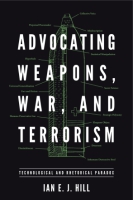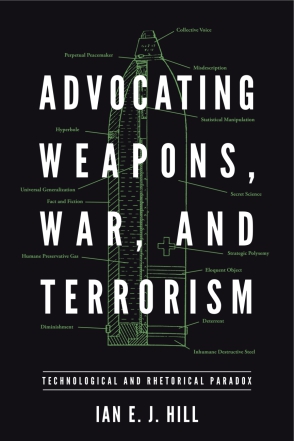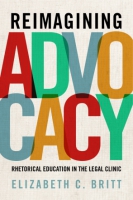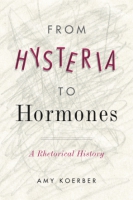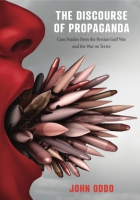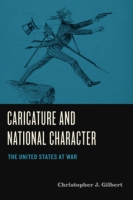Advocating Weapons, War, and Terrorism
Technological and Rhetorical Paradox
Ian E. J. Hill
“This is an impressive first book: well researched, carefully argued, and engagingly written. Hill posits ‘technological rhetoric’ as an original, interdisciplinary perspective on Technē’s Paradox. Grounded in thorough readings of rhetorical critique as well as science and technology studies, his longitudinal study of ‘machine rhetoric’ warrants attention both for the cases examined—from Malthus to the Unabomber—and for the individual and collective insights the analysis yields.”
- Description
- Reviews
- Bio
- Table of Contents
- Sample Chapters
- Subjects
Hill’s study analyzes the rhetoric used to promote such weapons in the nineteenth and twentieth centuries. By examining Thomas R. Malthus’s Essay on the Principle of Population, the courtroom address of accused Haymarket bomber August Spies, the army textbook Chemical Warfare by Major General Amos A. Fries and Clarence J. West, the life and letters of Manhattan Project physicist Leo Szilard, and the writings of Ted “Unabomber” Kaczynski, Hill shows how contemporary societies are equipped with abundant rhetorical means to describe and debate the extreme capacities of weapons to both destroy and protect. The book takes a middle-way approach between language and materialism that combines traditional rhetorical criticism of texts with analyses of the persuasive force of weapons themselves, as objects, irrespective of human intervention.
Advocating Weapons, War, and Terrorism is the first study of its kind, revealing how the combination of weapons and rhetoric facilitated the magnitude of killing in the nineteenth and twentieth centuries, and illuminating how humanity understands and acts upon its propensity for violence. This book will be invaluable for scholars of rhetoric, scholars of science and technology, and the study of warfare.
“This is an impressive first book: well researched, carefully argued, and engagingly written. Hill posits ‘technological rhetoric’ as an original, interdisciplinary perspective on Technē’s Paradox. Grounded in thorough readings of rhetorical critique as well as science and technology studies, his longitudinal study of ‘machine rhetoric’ warrants attention both for the cases examined—from Malthus to the Unabomber—and for the individual and collective insights the analysis yields.”
“Merging insights from rhetoric, science, and technology studies, Ian Hill analyzes how weapons are simultaneously cast as harbingers of extermination and preservers of peace, revealing novelty and innovation in words about weapons across two centuries. Advocating Weapons, War, and Terrorism is crisply written, thought-provoking, and hauntingly important.”
Ian E. J. Hill is Assistant Professor in the History and Theory of Rhetoric at the University of British Columbia and an affiliate faculty member of the Graduate Program in Science and Technology Studies.
Contents
AcknowledgmentsIntroduction: Technē’s Paradox and Weapons Rhetoric1. Thomas Malthus’s Population Bomb as a Pre-Text for Technē’s Paradox2. Preaching Dynamite: August Spies at the Haymarket Trial3. Humane, All Too Humane: The Chemical-Weapons Advocacyof Major General Amos A. Fries4. Toward a Peaceful Bomb: Leo Szilard’s Paradoxical Life5. Industrial Antipathy: Irreparability and Ted Kaczynski’s IEDsConclusion: In the Presence of Weapons and RhetoricNotesBibliographyIndex
From the Introduction, “Technē’s Paradox and Weapons Rhetoric
They will be obedient tools of destruction as long as the spirit contemplates destruction; and they will be constructive as soon as the spirit decides for great buildings.—Ernst Jünger (1932)But where danger is, grows / The saving power also.—Friedrich Hölderlin (1803)Technology will annihilate humanity—and technology will provide humanity’s only means of preservation from annihilation. This commonplace belief is what I call Technē’s Paradox. This technological and rhetorical paradox appears again and again in popular culture, especially in science fiction, like the Terminator movie trilogy (1984, 1991, and 2003) and TV shows like Battlestar Galactica (2004–9), Eureka (2006–12), and the revived Doctor Who series (2005–). In these science- fiction plotlines, technologies annihilate humanity and preserve it. They teach humanity that technology serves us until it kills us, and only what kills us can save us. Rhetorically, such narratives exhort humanity to take heed that its technological hubris will lead to disaster, and they exhort humanity to seek technological solutions for the most catastrophic problems. Technē’s Paradox, however, extends well beyond popular culture, permeating the rhetoric of people who ponder the advantages and disadvantages of myriad technologies in real- world, life- or- death situations.
Technē’s Paradox influences thought about a broad spectrum of technological dilemmas and their rhetorical deliberation. It undergirds the basic premises of risk analysis implemented by public policy- makers when deliberating the use of technologies vis- à- vis transportation safety, disease, and crime. It galvanizes environmental controversies about pollution, damming rivers, methods of agricultural production, and waste management. Fossil fuels and nuclear fission threaten global catastrophe for the sake of energy production, while wind and water turbines, solar arrays, and long- lasting batteries seem to offer the technological power to avoid or lessen such catastrophes. Technē’s Paradox animates assessments of capitalist consumer society and proliferates in descriptions of digital culture and futurism. It manifests when the stakes are not so high, and on the best and worst days, it reflects our exaggerated feelings about the most banal machines. On a hectic morning, the world-ending trauma of a broken coffeepot or a flat tire might make one overly conscious of how people depend on an assortment of “background technologies” for basic mental preservation.
The more dangerous the technology, though, the higher the stakes for negotiating the double truth bound together in the seeming inevitability of simultaneous technological destruction and technological preservation. This book focuses on some of the most dangerous kinds of technologies—weapons—and the rhetoric of their development and use. As Lewis Mumford wrote, “Real orgies of destruction, vast collective eruptions of hate, became possible only when civilization provided the technical means of accomplishing them.” Weapons facilitate humanity’s “orgies of destruction.” The nearly ubiquitous technological and rhetorical predicament of Technē’s Paradox and the threat of technological annihilation with weapons pervade humanity’s precarious relationship with machines and systems, inflecting our beliefs as well as our actions.Weapons are designed or appropriated with the explicit intent to kill. Yet in addition to their physical force, they possess geopolitical, ethical, and cultural forces. They are therefore the most critical of technologies for understanding Technē’s Paradox. The persistent pervasiveness of Technē’s Paradox in this context is observable as an ideology, as an anxiety, and as a rhetoric. As an ideology, Technē’s Paradox perpetuates the innovation, production, and deployment of weapons for the purposes of securing humanity from famine, plague, and war.As an anxiety, it presents weapons to the world’s population with the permanent threat of catastrophe, even extermination, while it also presents weapons as an anxiety-relieving panacea. As a rhetoric, it constrains and opens up the inventive scope of how people communicate about weapons and how weapons are persuasive. In this book, I argue that Technē’s Paradox is fundamental, if not inherent, in the ways that people use technologies to persuade and how technologies themselves are persuasive.I use the Greek term technē to describe this central technological and rhetorical paradox in order to draw attention to the close affinity between the worldmaking capacities of both rhetoric and technology. In short, technē means skillful craft. Aristotle, by defining rhetoric as a type of technē that involves the discovery and crafting of the available means of persuasion, linked rhetoric with technical activities as diverse as the crafting of health with medicine, the crafting of justice with law, the crafting of boats with shipbuilding, and the crafting of buildings with architecture. Martha Nussbaum defined technē as “a deliberate application of human intelligence to some part of the world, yielding some control over tuchē [luck]; it is concerned with the management of need and with prediction and control concerning future contingencies.” Universality, teachability, precision, and the “concern with explanation” further characterize technē for Nussbaum. A person possessing technē thereby possesses foresight, “some sort of systematic grasp,” and “some way of ordering the subject matter,” all of which instill preparedness for and control over technical matters. In these ways, the art of technology and the art of rhetoric overlap, just as the etymological roots of the word “technology” point toward an understanding of this word that welds skill in invention (technē) with language (logos). The overlap of technology and rhetoric in the idea of technē indicates that technological invention influences rhetorical invention, and rhetorical invention influences technological invention. Rhetoric can be considered “the logos of technē” and the technē of logos, or the persuasive capacity of both machines and words. Technē, as I use the term, thus refers to the co- creative world-making capacities possessed by rhetoric and by technology, by rhetors and by engineers, and by documents and by machines.Technologies do not kill alone. And neither do people. Both technology and people depend upon each other as well as upon language, language that is violent and language that motivates violence. Weapons rhetoric, or the ways by which people argue, debate, describe, advocate, and dissent against weapons—as well as how weapons themselves motivate belief and action—is such a language. Weapons rhetoric persuades people to kill through the ideological construction of political economies, religious dogmatism, patriotism, nationalism, racism, and hatred; through military strategists, commanders, and drill sergeants; through politicians, policy, technocracy, and diplomacy; through the mass media; through burgeoning weapons industries and capitalist expansion; through the militarization of science, engineering, and universities; through the marketing and selling of weapons to individuals, groups, and states; and through the physical presence of weapons.There is a growing body of scholarship on weapons rhetoric, including Lisa Keränen’s work on how “bio(in)security” promotes technological solutions for biological weapons attacks; Gordon Mitchell’s work on how “strategic deception” navigates and suppresses public debate about weapons systems; and Edward Schiappa’s work on how “nukespeak” discourages public involvement in nuclear policy- making. Moreover, Paul Virilio has been adamant that violence is inherent in communication, and that the “information bomb,” or “weapon of mass communication,” is not mere wordplay. At each moment when weapons have been deployed, and at each deliberative moment when peace has degenerated into war and when war has stuttered to a halt, people have wondered about whether weapons would cause humanity’s annihilation or its preservation. Weapons rhetoric is language that perpetually comes into conceptual contact with Technē’s Paradox. Thus, to speak or write about weapons has prompted thinking about how rhetoric helps spur people toward perpetual global peace or extermination. In turn, I call the various ways rhetors adapt their language to Technē’s Paradox “negotiating the Paradox.” As rhetors negotiate both the presence of weapons and the enigma of Technē’s Paradox, the fate of larger and larger populations depends on the power of rhetoric.1. The Dilemma of Technē’s ParadoxThe simultaneously preservative and destructive dual uses of nitrogen fertilizers are an initial example of how weapons, and technologies in general, summon Technē’s Paradox. At about nine o’clock in the morning of April 19, 1995, a truck bomb ripped into the Alfred P. Murrah Federal Building in Oklahoma City. The explosion traveled at 7,000 miles per hour and its force of 74,000 pounds equaled the force of a magnitude 4 earthquake. The primary explosive, ammonium nitrate fertilizer, demolished the building’s façade. Th e bombers, Timothy McVeigh and Terry Nichols, constructed the bomb by loading 108 fifty- pound bags of the fertilizer, three five- hundred- pound drums of nitromethane fuel, and some ammonium nitrate/diesel fuel oil (ANFO) explosives into a rental truck. They killed 168 people and injured 680. Th e surprise attack, which came in response to the US government’s 1993 raid of the Branch Davidian compound outside Waco, Texas, became, in an instant, a shocking reminder of synthetic fertilizer’s explosive power. The bombers did not convert fertilizer into a weapon so much as they implemented one of ammonium nitrate’s primary uses—killing lots of people.German chemist Fritz Haber, who in 1918 won the Nobel Prize in Chemistry, began researching how to make nitrogen fertilizers in the early twentieth century with the goal of feeding more people, not killing them. In 1911, the technology to mass- produce ammonium nitrate must have seemed to Haber like an unequivocal boon for humanity. Haber said of his discovery that “improved nitrogen fertilization of the soil brings new nutritive riches to mankind” to the extent that “the chemical industry comes to the aid of the farmer who, in the good earth, changes stones into bread.” However, once World War I broke out, Haber applied his ingenuity not only to feeding a hungry wartime population but also to exploding the enemy. By inventing an industrial process that combined nitrogen and hydrogen to create ammonia, he helped accomplish both feats. The Haber process, later refined by Carl Bosch, supplied Germany with a significant portion of the ammonium nitrate it needed to arm itself for four years of intensive warfare. Furthermore, Haber’s chemical acumen prepared him to oversee the first successful German chemical- warfare attack, and the first successful chlorine- gas attack, at Ypres, on April 22, 1915. In 1916, he became the director of Germany’s Chemical Warfare Service, and his Leuna- Werke—a vast chemical factory complex—provided Germany with chemical munitions and fertilizer as the primary producer of each. Thus, the same chemist whose technology empowered a massive increase in agricultural production in the twentieth century also empowered the widespread development of military explosives, the German push to inaugurate chemical warfare, and the ensuing international arms race. The huge expenditures on German chemical plants to produce dualuse nitrates propelled the expansion of the military- agricultural technology, an expansion that postwar population growth and agricultural necessity would make permanent, even with the destruction of some German chemical plants as per the dictates of the Treaty of Versailles. At the end of the twentieth century, ammonium nitrate both nourished the monoculture of Oklahoma’s cash crop—wheat—and exploded Oklahoma City’s Murrah Building. It nurtured, and then it destroyed. It continues to do both.Yet the ingenuity of the fertilizer truck bomb itself and its appropriation of commonplace industrial products did not result in the weapon’s vilification, in contrast to, for example, the vilification of hydrogen bombs and sarin nerve gas. To malign the mass production of ammonium nitrate, nitromethane, and rental trucks would be to disparage three fundamental components of the US economy—agriculture, chemistry, and transportation. To bar the products of German war technology from common use would threaten large populations with starvation. So should people live in fear of fertilizer or use it as definitive proof that humanity can invent technology to sustain itself? (Excerpt ends here.)
Also of Interest
Mailing List
Subscribe to our mailing list and be notified about new titles, journals and catalogs.
